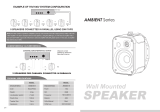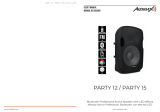
Oasis 6T MANUAL
DE USUARIO
1 2
Lista de empaque
Importante
Audibax ha hecho todo lo posible para proporcionar instrucciones precisas y
detalladas para el montaje de este producto. En caso de duda, consulte a un
instalador profesional cualificado, Audibax no se responsabiliza de cualquier
dificultad o problema derivado de la interpretación de estas instrucciones. Estos
soportes y todas sus partes y accesorios solo deben usarse para el propósito para el
que fueron construidos.
Audibax, sus distribuidores comerciales y minoristas no son, directa o indirectamente,
responsables de ningún daño a personas o propiedades derivados del uso de este
producto de forma insegura o diferente para la que ha sido diseñado y construido.
Varias partes de este producto son piezas pequeñas de hardware, por lo que se
debe tener mucho cuidado para mantenerlas fuera del alcance de los niños.
Lea atentamente estas instrucciones antes de utilizar el producto
1. Coloque el altavoz en una superficie nivelada.
2. No manipule ni golpee el woofer y el tweeter. Cualquier daño en funcionamiento
producirá desperfectos en el sonido.
3. No escuche el sonido a un nivel muy alto cuando esté cambiando la fuente de
entrada (por ejemplo, para sintonizar FM / CD) para la instalación o extracción de
cables asegurese de que el amplificador de potencia / dispositivo amplificador de
radio esté apagado.
4. No intente limpiar los altavoces con disolventes químicos, ya que esto puede
dañar la superficie pintada. Limpie solamente con un paño seco.
Cable o conducto a tierra directo
Según el tipo de instalación, puede ser adecuado enterrar directamente los cables
de los altavoces desde el amplificador hasta los altavoces, o puede ser necesario el
uso de un conducto de DI de 1"-1-1/2" para proteger los cables de posibles daños
físicos si se anticipan futuras excavaciones u otras alteraciones en el área de la
instalación
Altavoz manual de
usuario
Cable negro
Cable rojo
Alimentación de señal
del amplificador
Al siguiente altavoz
Altavoz
Interruptor
Panel de instalación de
soporte antirrobo
Las conexiones se pueden proteger usando uno de los siguientes métodos
- Suelde los cables juntos usando un tubo termorretráctil a prueba de agua para
sellar. Utilice conectores de cable a prueba de agua.
- Realice las conexiones con empalmes de crimpado resistentes a la inmersión.
- Utilice tapones para cables eléctricos.
Conexión
Use el cable en la parte posterior del altavoz en la pestaña de salida del amplifica-
dor (o amplificadores de radio). El cable del altavoz es de un lado rojo y del otro
negro. Conéctese al lado rojo de la pestaña (+) del amplificador y los altavoces.
Conecte un extremo del lado negro (-) en la otra pestaña. Conecte cada altavoz
para asegurarse de que no tenga la polaridad (+,-) invertida. Si se invierte la
polaridad de los altavoces, el sonido no será natural y se reproducirá sin graves.
Amplificación escasa vs. Abrumador
1. La mayoría de los daños en los altavoces son causados por amplificadores con
muy poca potencia (vataje).
2. Un amplificador saturado recorta las formas de onda y envía distorsión a los
altavoces.
3. El recorte suele ser audible; puede variar de un sonido áspero a un sonido borroso
o poco claro.
4. Si escucha el recorte a niveles de volumen altos, baje el volumen hasta que
desaparezca la distorsión.
5. La garantía no cubre los daños causados por operar los altavoz a niveles de
volumen distorsionados.
Entrada












